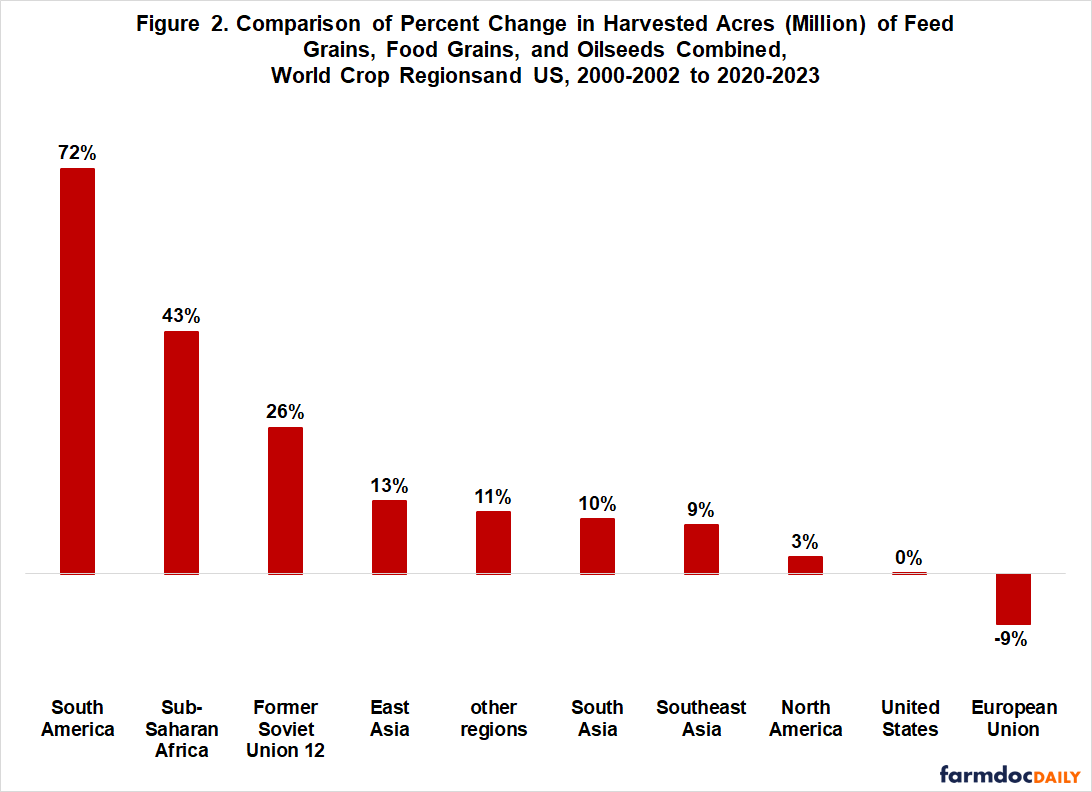Assessing US Performance: Land and 21st Century Field Crop Production
Around the turn of the century, a sharp break occurred. World harvested acres began to increase after a 20-year period of stability (see farmdoc daily November 16, 2022). Since then, the role of land in increasing crop output has varied notably by region. It has accounted for over 50% and 40% of the higher crop output in South America and Sub-Saharan Africa, respectively. For the world, harvested acres have been responsible for one-third of the increase in crop output since 2000. In contrast, higher crop output in the United States (US) and European Union (EU) was entirely yield dependent. The US dependency on yield prompts policy questions regarding US agricultural research and export programs.
Data
Average harvested acres of feed grains, food grains, and oilseed in 2000-2002 and 2020-2022 are compared for world geographical regions using data from the Production, Supply, and Distribution Online (PSD) database (US Department of Agriculture, Foreign Agriculture Service). Feed grains are barley, corn, millet, oats, and sorghum. Food grains are rice, rye, and wheat. Oilseeds are cottonseed, peanuts, rapeseed, soybeans, and sunflower seeds. The PSD website contains a list of countries in each world region (https://apps.fas.usda.gov/psdonline/app/index.html#/app/about).
Change in Harvested Acres
Since 2000, acres of feed grains, food grains, and oilseeds harvested annually in the world have increased by 374 million, or 1.64 times the annual acres of these crops harvested in the US (see Figure 1). Seventy-five percent of the increase occurred in South America (33%), Sub-Saharan Africa (26%) and the Former Soviet Union (15%). In contrast, harvested acres were flat in the US and declined in the EU. North American harvested acres grew because of Canada since harvested acres declined in Mexico.
Percent Change
Another useful metric is to compare percent change. For harvested acres, this measure of change has little impact on the rank order of the geographical areas. Again, South America, Sub-Saharan Africa and the Former Soviet Union stand out for their increase while the US and EU stand out for their lack of growth or decline (see Figure 2).
Land’s Relative Role in Increasing Production
A third metric is land’s role in increasing crop output. This metric involves (1) multiplying the change in average annual harvested acres over 2000-2002 to 2020-2022 by the average annual yield at the start of the period, then (2) comparing this multiplicative product to the total change in production over the analysis period.
Increased harvested acres was the majority factor in South America’s increase in production of feed grains, food grains, and oilseeds since 2000 (see Figure 3). Growth in harvested acres was responsible for over 40% of the increase in crop production in Sub-Saharan Africa. For the world as a whole, growth in harvested acres accounted for 33% of the increase in crop output.
Growth in US and EU crop output was totally dependent on higher yield or shifts in acres to higher yielding crops. See the farmdoc daily of September 22, 2023 for a discussion of the importance of the shifting mix of crops for US crop output.
Note that the percentages in Figure 3 are land’s minimum contribution (except for the US and EU). Land’s total contribution also includes the interaction effect between increased land and the growth in yield that has occurred in all regions since 2000.
Discussion
Around the turn of the century, world harvested acres began to increase. Since then, increased harvested acres has been responsible for at least one-third of the increase in world crop output. Increased acres have accounted for over 50% and 40% of the increase in crop output in South America and Sub-Saharan Africa, respectively.
In contrast, the US has had an effective limit on cropland. Reasons include conservation compliance policy constraints and physical limits on convertible land at current market returns.
This effective limit prompts two important policy questions:
- Does the US need to shift the focus of its public and private agricultural research? In particular, do more research dollars need to be put into increasing multiple cropping of a given acre during a given year? If the US does not make this transition, is it conceding an insular agriculture with a contracting international role (see farmdoc daily April 15, 2020)?
- Limited-to-no-expansion of cropped land increases the likelihood that the rest of the world, not the US, will capture any expansion in demand from US export programs, particularly over time. The US needs to carefully explore and discuss how its crop export programs should be designed so the US, not the rest of the world, captures their expansion of demand.
References
US Department of Agriculture, Foreign Agriculture Service. November 2023. Production, Supply, and Distribution Online. https://apps.fas.usda.gov/psdonline/
Zulauf, C. "The World’s Increasing Need for Cropped Land." farmdoc daily (12):173, Department of Agricultural and Consumer Economics, University of Illinois at Urbana-Champaign, November 16, 2022.
Zulauf, C., G. Schnitkey, N. Paulson and J. Colussi. "Concentration of US Crops in Corn and Soybeans: Importance to Increasing US Production of Grains and Oilseeds." farmdoc daily (13):173, Department of Agricultural and Consumer Economics, University of Illinois at Urbana-Champaign, September 22, 2023.
Zulauf, C. and K. Swanson. "US Corn, Soybeans, and Wheat in World Perspective: Importance of the US Cropped Acre Constraint." farmdoc daily (10):70, Department of Agricultural and Consumer Economics, University of Illinois at Urbana-Champaign, April 15, 2020.
Disclaimer: We request all readers, electronic media and others follow our citation guidelines when re-posting articles from farmdoc daily. Guidelines are available here. The farmdoc daily website falls under University of Illinois copyright and intellectual property rights. For a detailed statement, please see the University of Illinois Copyright Information and Policies here.










